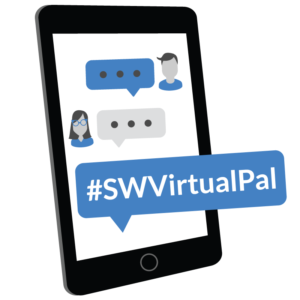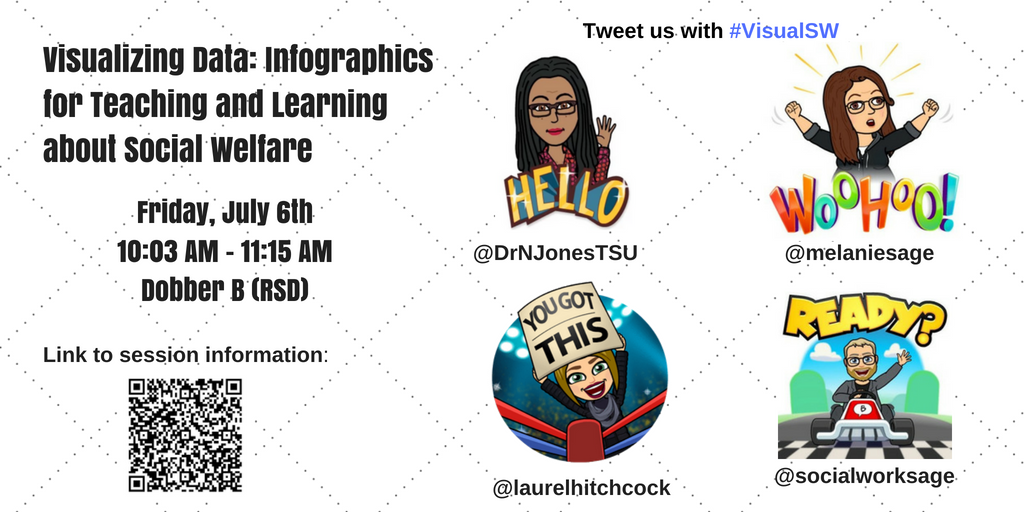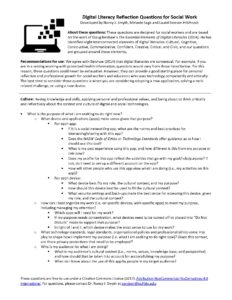#husITa18/#SWSD2018: A Connected Community of Learning for Practice: Social Work Virtual Pal
 On Friday July 6, 2018 at 5:39 PM in Dobber B of the RSD at the 2018 International Social Work, Education & Social Development Conference, we (Amanda Taylor and Laurel Hitchcock) will be presenting about #SWVirtualPal, an online community for social workers from around the globe with the goal of helping them to engage, learn from each other, and hopefully collaborate on international projects. The development of Social Work Virtual Pal, an innovation that builds upon the original ‘penpal’ idea, currently exists as a Twitter account @SWVirtualPal with an accompanying hashtag #SWVirtualPal. Because of our passion for digital and social technology, we designed Social Work Virtual Pal to promote and support connection through computer mediated engagement via Twitter (a microblogging social media platform), where we first met and connected. This community fills a need in global social work education and practice, that aims to link social work students, educators and practitioners from vast distances and across multiple time zones that in turn break down geographical boundaries. without having to leave their own location and using minimal resources.
On Friday July 6, 2018 at 5:39 PM in Dobber B of the RSD at the 2018 International Social Work, Education & Social Development Conference, we (Amanda Taylor and Laurel Hitchcock) will be presenting about #SWVirtualPal, an online community for social workers from around the globe with the goal of helping them to engage, learn from each other, and hopefully collaborate on international projects. The development of Social Work Virtual Pal, an innovation that builds upon the original ‘penpal’ idea, currently exists as a Twitter account @SWVirtualPal with an accompanying hashtag #SWVirtualPal. Because of our passion for digital and social technology, we designed Social Work Virtual Pal to promote and support connection through computer mediated engagement via Twitter (a microblogging social media platform), where we first met and connected. This community fills a need in global social work education and practice, that aims to link social work students, educators and practitioners from vast distances and across multiple time zones that in turn break down geographical boundaries. without having to leave their own location and using minimal resources.
In previous blog posts, we have shared our thinking around Social Work Virtual Pal, including ways that social work educators can incorporating @SWVirtualPal into the classroom. Here are links to these posts:
– #SWvirtualpal: Hashtagging for Connection
– Social Work Educator’s Guide for #SWVirtualPal
– Social Work Virtual Pal (#SWVirtualPal)… a very ‘real’ connection!
Below you’ll find our conference proposal and a link to our handout.. We’d love it if you joined us on Friday, July 7th and found your own #SWVirtualPal and shared your experiences about using online communities for learning and professional development.
Conference Handout: https://tinyurl.com/SWVirtualPalPoster
#husITa18/#SWSD2018: Visualizing Data: Infographics for Teaching and Learning about Social Welfare
 Today is the first day of 2018 Social Work, Education & Social Development Conference in Dublin, Ireland, and my first international social work conference. My first presentation will be with colleagues Nathalie Jones, Melanie Sage, and Todd Sage. We are presenting on the use of infographics in the Social Work curriculum on Friday July 6, 2018 at 10:03 AM in Dobber B of the RSD. This blog post does a few things. First, it offers an example of infographics as a tool for improving digital literacy with social work students. We also provide copies of all the presentation slides and handouts. Finally, this post helps us share and better disseminate our research findings.
Today is the first day of 2018 Social Work, Education & Social Development Conference in Dublin, Ireland, and my first international social work conference. My first presentation will be with colleagues Nathalie Jones, Melanie Sage, and Todd Sage. We are presenting on the use of infographics in the Social Work curriculum on Friday July 6, 2018 at 10:03 AM in Dobber B of the RSD. This blog post does a few things. First, it offers an example of infographics as a tool for improving digital literacy with social work students. We also provide copies of all the presentation slides and handouts. Finally, this post helps us share and better disseminate our research findings.
Three of us (Nathalie, Melanie & Laurel) have been using infographics as an assignment in our classrooms for several years and have even collected some data across our universities to ask students about the pros and cons. Guess what? The students overwhelmingly love infographic assignments. They appreciate working their creative muscles, like the opportunity to learn a new and transferable skill, and say they’ll use infographics again. Also, the technology can be a little bit frustrating, and some students are uncomfortable with the lack of structure. We argue that it’s good for students to sometimes get uncomfortable with lack of structure- this experience of managing some ambiguity is an important practice skill, as we know well!
We have shared this work in a variety of ways with our colleagues (from conferences to listservs & Twitter to water cooler conversations) in the US and are excited to bring infographics to an international conference. In a previous blog posts, we offer assignment details and even rubrics you can use to build your assignments if you are a social work educator. We share these in the spirit of service to our profession and to support your work. Here are links to these posts:
– #BPDNOLA17 – Visualizing Data: Infographic Assignments across the Social Work Curriculum: This post includes copy of the infographic assignment and links to tutorial videos.
– Teaching with Infographics: My experiences with digital literacy and non-traditional students: In this post, Nathalie provides details about how she incorporated infographics into her classroom.
Below you’ll find our conference proposal and a link to our slides. We’d love it if you joined us on Friday, July 7th and shared your comments and experiences about using infographics in the classroom.
Reflection Questions for Digital Literacy in Social Work
This post was written and edited by Nancy J. Smyth, Melanie Sage, and myself. It will be included in our forthcoming book, Teaching Social Work with Digital Technology, to be published by CSWE Press in 2018.
 Given the complexities of digital and social technology in today’s world and its effects on individuals, communities, and organizations, we argue that social work educators should teach students a holistic literacy of technology to promote, digital literacy, that is, the skills and knowledge to use information and communication technologies (ICTs) to find, critique, create, and share content (Heitin, 2016). Many websites have assessments that purport to assess one’s digital literacy. However, upon closer look, it is clear that they are often very dependent on the context of the technologies discussed such as a specific type of software, web-based application or mobile device. A good example of this in higher education is when we teach students to use a learning management system (LMS) like Canvas or Blackboard and focus only on how to upload a document within the LMS without helping them understand that the skill of uploading applies to many web-based platforms. By using digital literacy assessments with such a narrow focus, it means they become obsolete quickly and are not relevant to all contexts such as how features of an app may look different on a smartphone compared to a laptop.
Given the complexities of digital and social technology in today’s world and its effects on individuals, communities, and organizations, we argue that social work educators should teach students a holistic literacy of technology to promote, digital literacy, that is, the skills and knowledge to use information and communication technologies (ICTs) to find, critique, create, and share content (Heitin, 2016). Many websites have assessments that purport to assess one’s digital literacy. However, upon closer look, it is clear that they are often very dependent on the context of the technologies discussed such as a specific type of software, web-based application or mobile device. A good example of this in higher education is when we teach students to use a learning management system (LMS) like Canvas or Blackboard and focus only on how to upload a document within the LMS without helping them understand that the skill of uploading applies to many web-based platforms. By using digital literacy assessments with such a narrow focus, it means they become obsolete quickly and are not relevant to all contexts such as how features of an app may look different on a smartphone compared to a laptop.
To help social work educators and practitioners understand their own digital literacies more deeply as well as help others such as students or workshop participants, we are presenting some questions that serve as a starting point for reflection as you consider teaching with technology, as well as helping students enhance their digital literacies. These questions are grounded in the work of Doug Belshaw and his book The Essential Elements of Digital Literacies. He has identified eight interconnected elements of digital literacies: Cultural, Cognitive, Constructive, Communicative, Confident, Creative, Critical, and Civic, and our questions are grouped around these elements. Here are some brief definitions of each element with some sample reflection questions for each element (a handout with all the questions is available later in this post):
Social Work Virtual Pal (#SWVirtualPal)… a very ‘real’ connection!
 As with all other professions, social work has history of developing local and global ‘Communities of Practice’ (Farnsworth, Kleanthous & Wenger-Trayner, 2016 ). In previous times, the form and work of these communities were largely dictated by geography and cost. The time and financial implications of meeting ‘in person’ very much shaped the nature, the scope and the possibilities of the work; and meeting in person, at that time, was often the only feasible thing to do. The emergence of communication and social media type technologies has changed all of that. Dating back 30 years, new forms of social work academic communities (husITa, 2017) began to surface. Inasmuch as online communities and connections continue to materialize, survive and thrive, sadly notions of ‘real’ still permeate conversations regarding the online world (Couts, 2013; Zgoda & Shane, 2018).
As with all other professions, social work has history of developing local and global ‘Communities of Practice’ (Farnsworth, Kleanthous & Wenger-Trayner, 2016 ). In previous times, the form and work of these communities were largely dictated by geography and cost. The time and financial implications of meeting ‘in person’ very much shaped the nature, the scope and the possibilities of the work; and meeting in person, at that time, was often the only feasible thing to do. The emergence of communication and social media type technologies has changed all of that. Dating back 30 years, new forms of social work academic communities (husITa, 2017) began to surface. Inasmuch as online communities and connections continue to materialize, survive and thrive, sadly notions of ‘real’ still permeate conversations regarding the online world (Couts, 2013; Zgoda & Shane, 2018).
A recent example of a ‘real’ community of learning for practice is that of Social Work Virtual Pal, with its Twitter feed @SWVirtualPal and an accompanying hashtag #SWVirtualPal; the former used to facilitate connection and latter to collate and curate conversations. We, Laurel Hitchcock and Amanda Taylor developed Social Work Virtual Pal due to the benefits we each found from meeting regularly online. What began as a chance meeting on Twitter has turned into a connection that enables us to discuss issues relating to social work education in the US and the UK, and to consider the use of new technologies to support teaching, learning and global connections. To learn more about Social Work Virtual Pal, please check out our previous posts:


